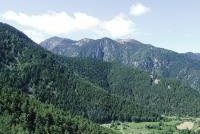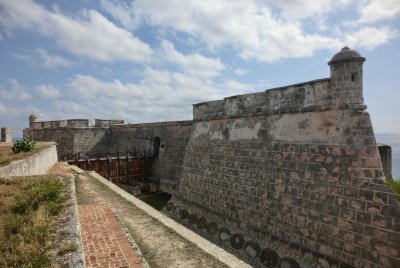Cuba
San Pedro de la Roca Castle
San Pedro de la Roca Castle, Santiago de Cuba, is considered the best preserved and most complete example of Spanish-American military architecture.
The castle and associated batteries protected the canal that leads up to the harbour of Santiago. It was designed by the Italian Giovanni Battista Antonelli in the Renaissance style. Built on a promontory with steep cliffs, a series of stairways connect the various levels. The fortress has been damaged and rebuilt several times after earthquakes and piracy attacks.
Community Perspective: locally known as El Morro, it is a pleasant excursion from Santiago. It can be reached on public transport via a local bus/boat combi, as described by Iain.
Site Info
Official Information
- Full Name
- San Pedro de la Roca Castle, Santiago de Cuba (ID: 841)
- Country
- Cuba
- Status
-
Inscribed 1997
Site history
History of San Pedro de la Roca Castle
- 1997: Inscribed
- Inscribed
- Type
- Cultural
- Criteria
- iv
- v
Links
- UNESCO
- whc.unesco.org
All Links
UNESCO.org
- whc.unesco.org — whc.unesco.org/
Community Information
- Community Category
- Secular structure: Military and Fortifications
Travel Information
Recent Connections
-
Perfect Inscriptions
1997 -
Bombarded by the British Navy
the Royal Navy under Rear Admiral Charl… -
Built or owned by Spanish
It was designed in 1637 by Giovanni Bat…
Connections of San Pedro de la Roca Castle
- Geography
-
-
Situated in one of the SIDS
Cuba 1997 -
Caribbean Sea
-
- Trivia
-
-
Built or owned by Spanish
It was designed in 1637 by Giovanni Battista Antonelli on behalf of Pedro de la Roca de Borja, a Spanish noble and the colonial governor of Santiago de Cuba from 1637 to 1640
-
- History
-
-
Located in a Former Capital
Cuba 1522-1589
-
- Architecture
-
-
Renaissance
Renaissance design -
Italian Architects outside Italy
Giovan Battista Antonelli
-
- Damaged
-
-
Destroyed or damaged by Earthquake
Between 1675 and 1692 the fortress was damaged by a series of earthquakes and reconstruction had to be carried out under the direction of Francisco Pérez between 1693 and 1695 ... it was again damaged by earthquakes between 1757 and 1766. (wiki) -
Bombarded by the British Navy
the Royal Navy under Rear Admiral Charles Knowles unsuccessfully bombarded this Cuban, Spanish-occupied castle, also called the Castillo del Morro, in April 1748 during the War of Jenkins' Ear.See en.wikipedia.org
-
- World Heritage Process
-
-
Perfect Inscriptions
1997
-
- Human Activity
-
-
Sea Ports
built to protect the important port of Santiago -
Man-made Terraces
built in a series of terraces -
Piracy
Houses the Museum of Piracy
-
- Constructions
-
-
Lighthouses
Dating from 1840 -
Prison
AB: "From 1775 the Castle served also as a prison and many important political figures where imprisoned there"
-
- Timeline
-
-
Built in the 17th century
As the conflict between Spain and England grew in the 17th century the governor of the town began the construction of a stone fortress in 1638 (AB ev)
-
News
No news.
Recent Visitors
Visitors of San Pedro de la Roca Castle
- Adrian Turtschi
- Alberto Rodriguez Gutierrez
- Alejandro Lau
- Alexander Barabanov
- Ali Zingstra
- A. Mehmet Haksever
- Anna Wludarska
- Atila Ege
- chiuliqi
- ChrisN
- Claire Bradshaw
- ctravel
- Daniela Hohmann
- Ertai
- Eva Kisgyorgy
- Felicité
- Femke Roos
- Filip Murlak
- Harald T.
- Iain Jackson
- Ivan Rucek
- Jacob Otten
- Jens
- Jonas Kremer
- KarenBMoore
- Lara Adler
- Lembu
- Loic Pedras
- Lucio
- Luis Filipe Gaspar
- Lukasz Palczewski
- lynnz317@aol.com
- Malgorzata Kopczynska
- marcel staron
- MarcoB_0
- Martina Rúčková
- Mazeman
- MH
- Mikko
- Nihal Ege
- PabloNorte
- Paola Laura
- Patrik
- Paul Schofield
- Philipp Leu
- Reisedachs
- Reza
- Roman Bruehwiler
- Sabrina Liebehentschel
- Stanislaw Warwas
- Tatiana Nikulnikova
- Thomas Buechler
- Thomas van der Walt
- triath
- Vanessa Buechler
- Zizmondka
- Zoë Sheng
Community Reviews
Show full reviews
Visited in February 2023.
Like Havana, Santiago de Cuba is built on a bay that goes deep enough into the land. Like in Havana, the fairly narrow entrance to this bay was easily protected by fortification systems. The Spaniards spared them no money. The island was a transshipment base for armadas of galleons loaded with precious metals from the New World, and pirates in the 17th and 18th centuries began to attack cities with the aim of extracting booty from them.The fortress on the rocky promontory of El Morro, 10 km from Santiago (easy taxi ride), began to be built in 1638 under the leadership of the Milanese engineer Giovanni Battista Antonelli, and it was done intermittently until the end of the century (and then expanded further). As a result, a powerful four-level fortification came out, descending in tiers from the top of the cape to the surface of the water.When the pirates got out, the fort was used as a prison, and then it was completely abandoned. But in the 1960s it was restored quite carefully and is considered the largest and best preserved example of Spanish-Italian Renaissance bastion fortifications in the Americas. The most pleasant impression is the opportunity to observe the harbor from the fortifications, and then you understand the idea of the creators of the fortress.
Keep reading 0 comments
Visited this site in May 2018.
Castillo de San Pedro de la Roca del Morro is located about 10 km to the south from Santiago de Cuba on a strategic rock controlling harbor entrance. After over 150 years of painful planning, designing and construction, many times interrupted by the military attacks from competing colonial powers and pirates and earthquakes, it was more or less completed only in 1700s. The fortress served as prison once pirate threat declined in 18th century (you could visit some tiny prison cells). Castillo is considered the best-preserved Spanish colonial military fortress. It is quite compact site with stunning views over the sea, deep mounds, sharp edges and everything you expect from a military fortress. For a European eye is does not look something special but taking into consideration all the circumstances Castillo found its deserved place in the WHS list. Inside there are some rooms dedicated to the Caribbean piracy.
All in all, good site and pleasant excursion from Santiago de Cuba.
Keep reading 0 comments
This site, known locally as El Morro, was easily reached from Santiago de Cuba at the time of my visit in February 2001. A local bus will take you to Ciudamar, a settlement on the southern shore of the almost enclosed bay with Santiago at its head, and from there it is possible to catch one of the little launches which shuttle between various points on the bay. I went first to La Socapa, a small village at the foot of the hill, from the easily reached top of which, excellent views of the castle across the narrow(400m?) entrance to the harbour, and indeed for miles along the coast in both directions, can be had.
I was surprised not to find any evidence of fortification on this side of the harbour entrance.
Once back in Ciudamar it's a walk of about 20 minutes to the foot of the hill on which the castle itself is located. It has grown over several different levels, the lowest being a little above the high water line with some of the rooms carved out of the soft rock.
At a higher level the castle is protected by a deep moat and bastions at every change in direction of the castle's hefty wall.The various levels are connected by staircases and by a series of tunnels which is fun to explore
Some of the castle rooms are now used as a museum illustrating local building techniques and telling the story of piracy in the region. There …
Keep reading 0 comments
